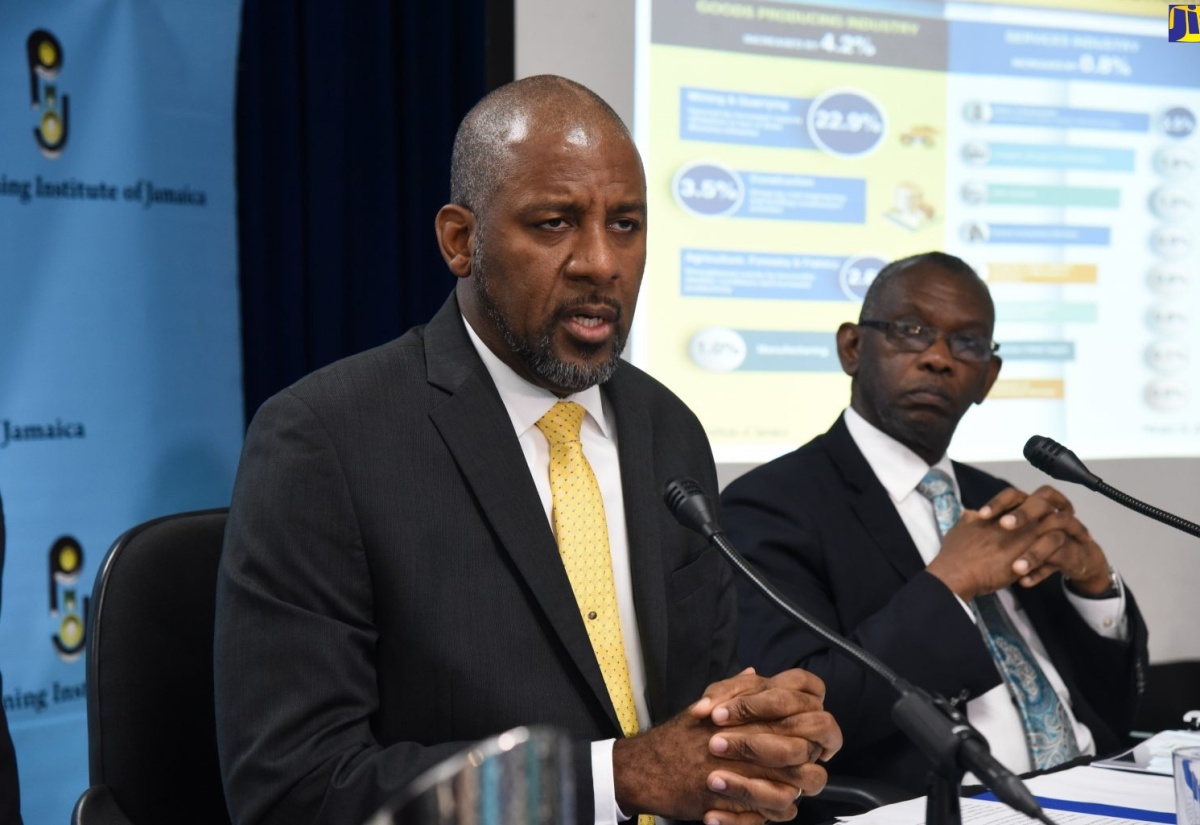Growth of 1.7 % for October to December 2018 Quarter
By: , February 21, 2019The Key Point:
The Facts
- Director General, Dr. Wayne Henry, says this reflected an estimated 4.2 per cent increase in the goods producing industry and a 0.8 per cent out-turn in the services sector.
- Key growth drivers, he said, included increased external demand for some goods and services from Jamaica’s main trading partners; increased hotel room and air seat capacity, facilitating a growth in stopover visitor arrivals; major road, and residential and commercial building infrastructure works; and major capacity utilisation in the mining and quarrying industry.
The Full Story
The Planning Institute of Jamaica (PIOJ) is reporting that the economy grew by an estimated 1.7 per cent over the October to December 2018 quarter, as against 1.8 percentage points during the preceding period.
Director General, Dr. Wayne Henry, says this reflected an estimated 4.2 per cent increase in the goods producing industry and a 0.8 per cent out-turn in the services sector.
Key growth drivers, he said, included increased external demand for some goods and services from Jamaica’s main trading partners; increased hotel room and air seat capacity, facilitating a growth in stopover visitor arrivals; major road, and residential and commercial building infrastructure works; and major capacity utilisation in the mining and quarrying industry.
Dr. Henry was speaking at the PIOJ’s quarterly briefing at the agency’s head office in New Kingston, on Wednesday (February 20).
Mining and quarrying with estimated growth of 22.9 per cent, construction which grew by 3.5 per cent, and agriculture, forestry and fishing, up 2.6 per cent, were the top performers in the goods producing industry.
Dr. Henry said the out-turn for mining and quarrying was buoyed by a 30.8 per cent increase in alumina production over the review period, driven mainly by increased capacity utilisation at the Alpart and Jamalco refineries.
He noted that this outweighed crude bauxite production, which fell by 19.4 per cent, largely reflecting reduced third-party client demands.
The construction industry’s out-turn reflected growth in building and other (civil) development, the latter of which was supported by a 61.6 per cent increase in asphalt production.
Dr. Henry said building construction was supported by a 54 per cent increase in total housing starts, 17.2 per cent in total mortgages disbursed by the National Housing Trust, and work in progress on developments previously started.
He pointed out that the increase in the civil (other construction) component resulted from higher expenditure by six of the seven reporting entities.
These included the National Works Agency, which disbursed $7 billion, up 112.7 per cent; Port Authority of Jamaica, which allocated $3.7 billion, representing a 92 per cent increase; and Jamaica Public Service Company, which disbursed $6.1 billion, reflecting a six per cent increase.
“This outweighed the impact of lower disbursement by the National Water Commission, which disbursed $395.5 million, down 63.2 per cent compared with the similar quarter of 2017,” the Director General told journalists.
He further indicated that the out-turn for agriculture, forestry and fishing largely reflected a 7.1 per cent growth in the ‘Other Agricultural Crops’ category, due to more favourable weather conditions during the review quarter.
The other goods producing subsector, manufacturing, grew by an estimated one per cent.
Hotels and restaurants, which grew by an estimated 2.5 per cent, dominated the services industry’s performance.
Dr. Henry said the out-turn was influenced by an estimated 3.7 per cent increase in foreign national arrivals.
This, he pointed out, resulted from an increase in visitors from the United States, while noting that arrivals from Canada and Europe declined during the period.
“Stopover arrivals from the USA increased by 8.2 per cent to 399,269 persons, [while] stopover arrivals from Canada declined by 4.5 per cent to 106,521 persons; and stopover arrivals from Europe fell by 1.1 per cent to 85,608 persons,” the Director General noted.
Meanwhile, Dr. Henry said cruise-passenger arrivals declined by 12 per cent to 521,819 persons, due to contractions in the number of visitors arriving at Falmouth and Montego Bay.
These, he further noted, outweighed the increase in arrivals recorded at the Ocho Rios Port, while adding that total visitor expenditure rose by 11.6 per cent over the corresponding quarter in 2017, to US$840.4 million.
Preliminary arrivals for January 2019 show a nine per cent increase over the corresponding month last year.
Dr. Henry said 2018 calendar year growth is estimated at 1.8 per cent. This, he added, represents the sixth consecutive year of economic growth recorded.
This out-turn, he further pointed out, was facilitated by increased external demand for local goods and services; increased domestic demand, underpinned by record levels of employment; and improved macroeconomic stability reflected in relatively low inflation, and the lowering of interest rates.
The goods producing industry is estimated to have grown by 4.8 per cent and the services sector – 0.8 per cent.
Dr. Henry said the economy is projected to grow within the range of 1.5 to 2.5 per cent for the January to March 2019 quarter, and 1.5 to two per cent for the 2018/19 fiscal year.


